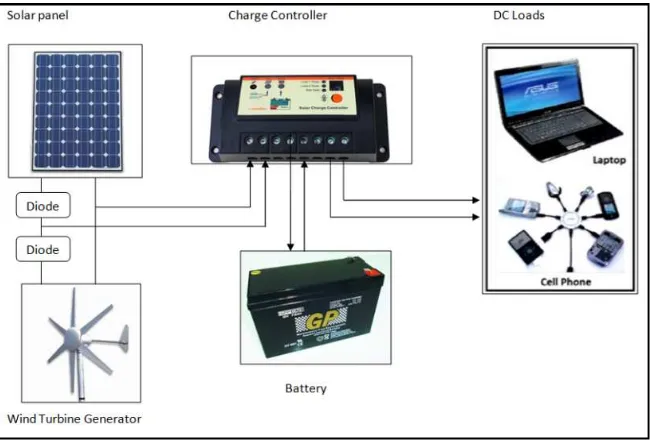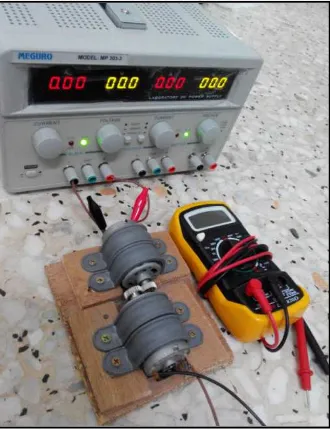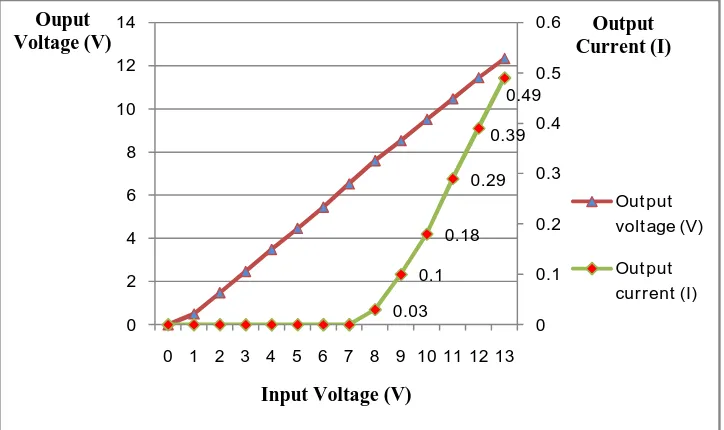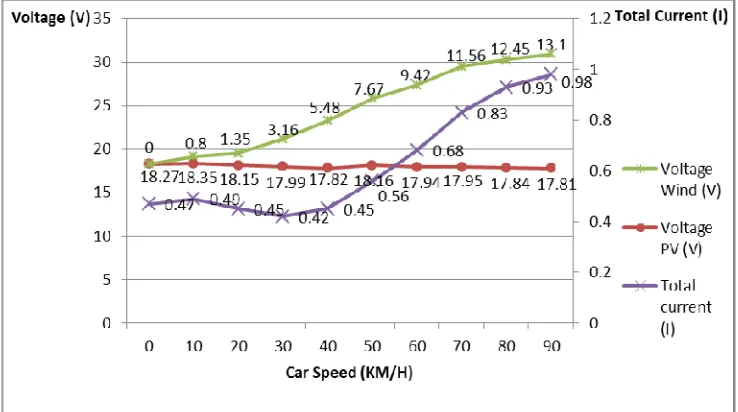ISSN 0973-4562 Volume 9, Number 21 (2014) pp. 8799-8810 © Research India Publications
http://www.ripublication.com
Development of Hybrid PV Wind Harvesting Energy for
Electric Vehicles
M. N. M. Nasir, A. B. Yusoff, Z. H. Bohari, M. F. Sulaima, W. M. Bukhari,A. N. Ramani
Faculty of Electrical Engineering Universiti Teknikal Malaysia Melaka Hang Tuah Jaya 76100 Durian Tunggal Melaka
Abstract
The technology of electric vehicles (EV) is conventionally using battery to operate the motor. However it has one major disadvantage on energy storage capacity. Basically the battery needs to be recharged every day at the charging station which usually takes hours to fully charged. In this paper, the concept of battery charging using the hybrid PV-Wind for electric vehicles energy source is presented. The prototype of photovoltaic (PV) and wind energy harvesting has been developed to overcome this problem in the most effective way. This prototype will harvest the energy from both PV and wind to recharge the battery in electric vehicles so that the car can travel in longer time and distance. Three experiments have been conducted to analyze the best system namely PV system, wind generator system and hybrid PV wind system. Based on the experiment that has been carried out, it can be concluded that the hybrid PV wind system is the best compared to the other two because the current generated by hybrid PV wind is the highest which is 1A compared to 0.51A by PV system and 0.67A by wind system, respectively. The high current value is significantly means that the time taken to fully charge the battery is faster and this will lead to decrease the time used for the charging process.
Keywords: PV Wind, electric vehicle, wind turbine, energy storage
1 INTRODUCTION
There are a lot of charging patterns for EV and the simplest way is a non-steered charging pattern which the EV is able to be charged anytime and connected to the grid independent from any other resources that produce solar energy. Non-steered charging pattern is combined with solar charging pattern to get minimal state of charge. This means that the battery of EV will be charged if there is existence of solar energy from photovoltaic rooftop system. The charging with solar energy helps to reduce the emissions from the power grid but increases the cost of charging. Moreover, it offers more flexibility to prepare for the emergence of new technologies (e.g., Vehicle-to-Grid, Vehicle-to-Building, and Smart Charging), which will become a reality in the near future [2]. There are two options whether to choose high minimal state of charge which means users can keep losses low mobility or to choose low minimal state of charge which means users increase the amount of solar energy directly charged [3].
The method proposed in this paper is used Photovoltaic and wind generator to charge the battery for EV. Photovoltaic system is one of the most popular renewable energy among the others. It converts the sun energy into electrical energy by using photovoltaic cells. Since solar energy is the most abundant energy source on the planet, PV system can be classified as a vital technology that needs to be explored extensively in order to preserve our planet. A PV cell is basically a semiconductor diode whose p–n junction is exposed to light [4].
The process of wind turbine generator is by using the wind energy to rotate the wind turbine blade that was attached to the shaft of the generator. When the rotating occurs, the shaft will spin and the generator will change the mechanical power into electricity. Wind turbines are used to generate electricity from the kinetic power of the wind. Wind energy is plentiful, renewable, widely distributed, cleans, and reduces toxic atmospheric and greenhouse gas emissions if used to replace fossil-fuel derived electricity [5].
The wind turbine typically consists of two basic type namely horizontal axis and vertical axis. There are many researchers implement the hybrid system in many applications. In [6], two different microsources, PV and wind turbine (WT) with battery storage applied for a small scale microgrid system. Hybrid system of PV and Wind Turbine had produced such a promising result by using only the natural resources compared to the stand-alone resource [5]. The objective of this paper is to analyze the electrical performance in term of voltage and current produced of hybrid PV wind system. In order to do that, several experiments has been carried out.
2 METHODOLOGY
2.1 Prototype Development Process Steps
reliability. If failure occurs, the problem will be detected and the best solution will be taken to overcome that problem. After the installation of PV wind system at the body of car part is finished, the testing of the prototype will be conducted in indoor and outdoor environment.
2.2 Hybrid PV Wind System Overview
Figure 1 shows an overview of the development of hybrid PV wind harvesting for EV encompasses solar panel and wind turbine generator as the charging method to the storage system. The main components in this system are solar panel, wind turbine generator, solar charge controller, battery and DC loads. The solar panel captures the sun's energy using photovoltaic cells then the cells convert the sunlight into electricity. Meanwhile the wind rotates the generator blade and converts the kinetic energy to mechanical power.
Figure. 1. Overall System of Development of Hybrid PV Wind Harvesting for EV
Then the generator will convert the mechanical power to electricity power. The output energy from PV and wind turbine will be stored in rechargeable battery. The solar charge controller function is to protect the battery from being over charged by photovoltaic and wind system and to stop reverse current from battery. At the same time it will protect over discharged by the loads. The solar charge controller also installed with temperature sensor which will help to accurately regulate the charge of the battery bank.
2.3 Calculation of Hybrid PV Wind System
The time value can be calculated using equation 1.
T = AH / I (1)
where,
T = Time taken to charge
AH = Ampere Hours (Battery current rating used in this project is 1.2AH) I = CURRENT
3 RESULTS AND DISCUSSIONS 3.1 Experiment Using DC Generator
Two experiments were conducted using DC generator system to validate the accuracy of output results. For this experiment, two 12V DC motors are coupled together whereby each of them will act as a motor or a generator, respectively as shown in Figure 2. The variable DC power supply is applied to the motor within 0V – 13V to observe the change of current and voltage at the other motor, which acted as generator. Figure 3 and Figure 4 shows the output voltage and current versus input voltage for Experiment 1 and Experiment 2, respectively. From Figure 3 and Figure 4, it can be seen that the output voltage is directly proportional to the input voltage, whereby when the input voltage is increased, the output voltage is also increased.
Figure. 2. 12V DC Generator with Variable DC Power Supply
output current at 0V – 7V is caused by the generator output voltage has less voltage than the load’s. The output voltage which is proportional to the input voltage means that the generator will produce output voltage depends on the input voltage. It is confirms the ohm’s law which stated that the current through a conductor between two points is directly proportional to the potential difference across the two points.
Figure. 3. Results for Experiment 1
Figure. 4. Resultsfor Experiment 2
3.2 Experiment using Photovoltaic (PV) Panel hour from 1.15 pm to 1.43 pm in a bright sunny day. Figure 5 and Figure 6 shows the output voltage and current versus time for Experiment 3 and Experiment 4 respectively.
Figure. 5. Results for Experiment 3
Figure. 6. Results for Experiment 4
3.3 Experiment Using Wind Generator
Figure. 7. Results for Experiment 5
Figure. 8. Results for Experiment 6
This is happen because of the generated output voltage is less than the load voltage. This explains why the current is still zero even though the car has start moving. Based on Equation 1, the time used to fully charge the battery is 1.79 hours.
3.4 Hardware of hybrid PV and wind turbine system
Experiment 7 and Experiment 8 are conducted using hybrid PV and wind generator system. This experiment is done on the Melaka road from Bukit Beruang to Universiti Teknikal Malaysia Melaka main campus. The voltage and current from PV and wind turbine is recorded using digital multimeter based on the speed of the car. Figure 9 and Figure 10 shows the recorded voltage and current versus car speed for Experiment 7 and Experiment 8, respectively. Experiment 7 was done during the sunny day. Based on Figure 9, the total current is the summation of the current from PV and wind turbine. The voltage of wind turbine depends on the speed of the car meanwhile the voltage of PV depends on the light intensity. The voltage produced by wind turbine is increased steadily due to the increased value of the car speed. There are slightly change in voltage produced by PV.
Figure. 10. Results for Experiment 8
The combination of PV and wind turbine has successfully increased the total current produced. From the graph, it can be seen that for the first 40km/h, only PV produce the current for the system but after that, the wind turbine also produce the current. The highest current recorded is 0.98A. From Figure 10, it can be seen that the voltage produced by the PV are almost in the constant values. There are only slightly changes in PV voltages and the graph is parallel with the X-axis. For the wind turbine voltages, the graph increased proportionally to the car speed. For the total current, it can be seen that no obvious changes in the first 40 km/h and increased steadily after that for 50km/h to 90km/h. The highest total current recorded is 1A.
Based on the result for both Experiment 7 and Experiment 8, there is only a slight different for the output voltages produced by PV, output voltages produced by wind turbine and total currents. The output voltage produced by the wind turbine depends on the speed of the car meanwhile the output voltage of the PV depends on the solar-radiance intensity. For the first 40 km/h, the total currents are only produced by the PV and after that it is also produced by the wind turbine which this can be seen clearly in the steadily increased graph in Figure 9 and Figure 10. The PV was connected in parallel with the wind turbine, and based on the Kirchoff’s Current Law (KCL), the amount current is the total current produced by both PV and wind generator. This explains why the total current for hybrid PV and wind turbine is higher compared to the single system of PV or wind turbine only. Based on the result for both experiments, the highest current generated is 1A which is recorded in Experiment 8. Based on Equation 1, the time used to fully charge the battery is 1.2 hours.
Figure. 11. The highest current generated from Experiment 3 until Experiment 8
From Figure 11, it can be seen that the highest current generated is by using the hybrid PV wind system. Based on the calculation using Equation 1, the time used to fully charge the battery, using hybrid PV is less than the wind generator system which is suitable to be applied to the EV.
4 Conclusions
The small scale prototype of wind turbine and photovoltaic system to charge the battery was successfully developed in the prototype. The system was tested to analyze the electrical performance in term of voltage and current produced. This prototype has successfully harvest the energy from both PV and wind to recharge the battery in electric vehicles which allowed the car to travel in longer time and distance.
5 acknowledgement
The authors would like to acknowledge Centre of Excellence UTeM (CeRIA) and Universiti Teknikal Malaysia Melaka for the financial support of this research. This research is supported under the Research Acculturation Collaborative Effort Grant Scheme (RACE) with project code: FRGS(RACE)/2013/FKE/TK3/3/F00204.
References
[1] Hori, Y.,” Future Vehicle Driven by Electricity and Control-Research on Four-Wheel-Motored “UOT Electric March II” ”, IEEE Trans. on Industrial Electronics, 51, 5(2004), 954-962.
[2] R.Arulbel Benela, Dr. K. Jamuna,” Design of Charging Unit for Electric Vehicles Using Solar Power”, in International Conference on Information Communication and Embedded Systems, 2013.
0 0.2 0.4 0.6 0.8 1 Experim ent 3
Experim ent 4 Experim ent 5 Experim ent 6 Experim ent 7 Experim ent 8
Current (I)
[3] L. Ritte, S. Mischinger, K. Strunz and J, Eckstein, “Modeling Photovoltaic Optimized Charging of Electric Vehicles”, in 3rd IEEE PES International Conference and Exhibition on Innovative Smart Grid Technologies (ISGT Europe), 2012.
[4] A. S. Sedra and K. C. Smith, “Microelectronic Circuits”, Oxford Univ. Press, London, 2006.
[5] M. N. M. Nasir, N. Z. Saharuddin, M. S. Yahaya, M. S. Jamri, I. Ismail, “Stand Alone Photovoltaic-Wind Hybrid System for 100W Motor”, in Proc. Power and Energy Conversion Symposium (PECS), 2012.





